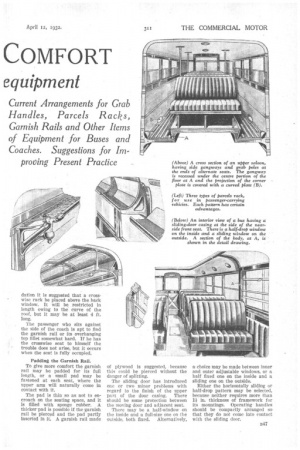SAFETY and
Page 64

Page 65

If you've noticed an error in this article please click here to report it so we can fix it.
COMFORT
in interior equipment
Current Arrangements for Grab Handles, Parcels Racks, Garnish Rails and Other Items of Equipment for Buses and Coaches. Suggestions for Im proving Present Practice
AMONGST the most important items of interior equipment for passenger vehicles may be included handles, for expensive claims may follow accidents caused to travellers through a fall while passing to or from a seat.
Upright grab poles are used in both upper and lower saloons, also as commode handles at wide entrances, such as at the rear of double-deckers. In the saloon these poles, which consist of metal tubes, are fastened to the roof and floor, and are placed at the back of the seats so that the central gangway is not impeded. Any obstruction which the poles may cause is further reduced by placing them at the backs of alternate seats.
The lower part of the pole is shaped to the inclination of the seat back, to which it is fastened, and thus occupies a minimum of space in the cross gangway.
Uses of the Grab Pole.
The pole helps to support the roof and reinforces the seat structure. Its value as a support is lessened somewhat, because the lower part is bent, but this mechanical disadvantage is offset by the fact that there is no other type of commode handle which is so easily grasped.
The pole may also be secured to the top of the seat back and is not extended to the floor. With this arrangement there is less obstruction of the cross gangway.
The curved sides of the roof above the windows of a coach are used for parcels and light luggage. Parcels racks restrict the headroom of the passengers sitting against the sides of the vehicle.
When racks are present it is considered that there should be two or three inches more height between the floor and top of the cant-rail than in a coach not thus fitted, especially if the underside of the racks be panelled and the lamps project.
This extra heddroom may increase the total inside height from floor to roof at the centre gangway, although a compromise may be made by re B46 ducing the height between the cantrail and the top line of the roof.
The rack should not be more than 1 ft. 3 ins, wide and the under surface, if panelled, should he light in colour, so that it forms a reflecting surface.
The parcels-rack brackets are designed for screwing to the face of the cant-rail, pillar top and hoopstick. Any or all of these fixings place, or the front has an extra rail or it is provided with a fillet.
With racks along each side of the vehicle most of the passengers have space for the disposal of parcels within easy reach, but seldom are similar facilities provided for those occupying the back seats. The racks finish at the last side window or at the entrance.
To obviate this lack of accommo dation it is suggested that a crosswise rack be placed above the back window. It will be restricted in length owing to the curve of the roof, but it may be at least 4 ft. long.
The passenger who sits against the side of the coach is apt to find the garnish rail or its overhanging top fillet somewhat hard. If he has the crosswise seat to himself the trouble does not arise, but it occurs when the seat is fully occupied.
Padding the Garnish Rail.
To give more comfort the garnish rail may be padded for its full length, or a small pad may be fastened at each seat, where the upper arm will naturally come in contact with it.
The pad is thin so as not to encroach on the seating space, and it is filled with sponge rubber. A thickerpad is possible if the garnish rail be pierced and the pad partly inserted in it. A garnish rail made of plywood is suggested, because this could be pierced without the danger of splitting.
The sliding door has introduced one or two minor problems with regard to the finish of the upper Part of the door casing. There should be some protection between the moving door and adjacent seat.
There may be a half-window on the inside and a full-size one on the outside, both fixed. Alternatively, a choice may be made between inner and outer adjustable windows, or a half fixed one on the inside and a sliding one on the outside.
Either the horizontally sliding or half-drop pattern may be selected, because neither requires more than 1-k in. thickness of framework for its mountings. Operating handles should be compactly arranged so that they do not come into contact with the sliding door.




































































































